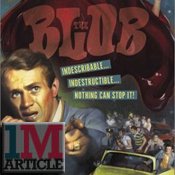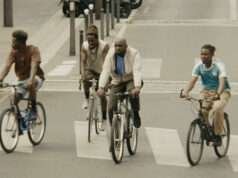The Struggle between Order and Abject: Irvin Yeaworth’s The Blob. (1958)
The 1950s was a period of wonder and worry for the United States public. There was the peace that arose out of World War II, as well as fear of the spread of Communism. The decade was known as a time of prosperity and as a time of restlessness; a time of traditionalism and a time of rebellion. In cinematic terms, the 1950s was known as the classic era of science fiction. The films involved aliens or monsters, invading or otherwise threatening humanity. Though, at their core most represented political themes and deep-rooted public fears. The Paramount film, The Blob, directed by Irvin S. Yeaworth, Jr., was no exception.
The Blob was a hit horror/science fiction movie when it was released in 1958. The film is about two teenagers, Steve Andrews (Steve McQueen, in his first leading role) and Jane Martin (Aneta Corsaut), who witness a meteorite crash over a nearby hill. They investigate and encounter an old man (Olin Howland) with some sort of gelatinous substance stuck to his hand. They take him to the town doctor, Dr. Hallen (Stephen Chase), who is baffled by the substance and its parasitic nature. The teenagers become worried after the old man and doctor disappear when left alone with the substance and are sure a monster is on the loose. They take their suspicions to the police who are hesitant to believe the teens. Lt. Dave (Earl Rowe) struggles to believe the teens as Sgt. Jim Bert (John Benson) is convinced it’s just another teen prank. As they continue to meet skepticism from parents and townspeople alike, the substance has grown into a gelatinous monstrosity continuing to consume more and more, growing in size until its existence is undeniable. Eventually, unable to destroy the monster, the townspeople are relegated to freezing it in hopes that a military airdrop into the Arctic will ensure it never thaws and escapes.
To the original 1958 theatrical audiences, the film represented the disenfranchised youth struggling to find acceptance in a society that didn’t understand or accept them. This same society was consumed by its own excess, not understanding the culture of fear that was looming over their heads. This is very prevalent in a particular scene of the film where the teens are trying to convince the police of the monster on the loose. This scene thrusts the abject horror into the face of established order, threatening to rock the foundations of logical reason and societal order.
I’ll analyze the scene, breaking it down in cinematic terms. As the scene opens, we’re inside the Downington Police Station, where Lt. Dave is standing over Officer Richie (George Karas), as Sgt. Jim Bert sits at his desk in the background. It’s a 3-shot, with the view at Lt. Dave’s waist level. The three police officers are discussing the game of chess. The presence of the chess set represents logic and order, symbolic of the national body at ease. Suddenly, two people enter the frame from the rear, again with the view at waist level. The camera pans up to reveal a panicked Steve and Jane, as Lt. Dave turns to meet them, while the other two officers stand to join them in a medium 5-shot. As the camera zooms into a tighter medium 3-shot, Steve and Jane try to explain to Lt. Dave that they believe Dr. Hallen has been killed. The camera cuts to Sgt. Bert and Officer Ritchie as they inquire what really happened. The camera quickly cuts back to the 3-shot as Steve is unable to articulate fully what he has seen. Cut to a close shot of Sgt. Bert as he expresses his disdain for Steve’s story of a monster before cutting to a medium 5-shot of all of them. The camera slowly pans right and slowly zooms in for a tighter medium shot as Lt. Dave tries to restore order by attempting to make sense of the claims. Cut to a 2-shot of Sgt. Bert, with Officer Ritchie slightly in the background, as he tries to convince Lt. Dave that this is just another teen gag. The camera then cuts to a close shot of Lt. Dave as he rationalizes the facts and determines that the claim has to be checked out. The camera pans left as Lt. Dave joins Steve and Jane as they head out to investigate, with Sgt. Bert grudgingly following behind them. As he leaves, Sgt. Bert looks back to Officer Ritchie (off-camera). Cut to Officer Ritchie in a medium shot as he sits on his desktop with a puzzled look on his face. He slowly rises as the camera zooms in to a close shot and pans left slowly before following him to the right where we watch Officer Ritchie, with camera holding frame as he walks toward the window to peer through the blinds to the sound of his colleagues driving off. Ominous music begins to play in the background as Officer Ritchie turns around. Cut to a medium shot of Officer Ritchie as he walks towards the camera, which pans left and then tilts down slightly to follow as he sits down at his desk. The music continues as Officer Ritchie pulls his chess set from inside his desk drawer, just out of camera frame. He contacts another police station via radio and exchanges chess moves. After Richie realigns the chess pieces the camera pans down to reveal that he has lost the game.
*****
This scene is full of symbolism indicative of the struggle that is unfolding in the film. If the doctor is indeed dead, in such a way as Steve is unable to fully articulate, this is a form of abjection as acclaimed psychoanalyst Julia Kristeva would assert. Kristeva describes abjection as that which is cast off; that which disturbs the social order; which is monstrous. The thought of an indescribable corpse would be the ultimate in abjection, or in this case, to Steve, a corpse that has been totally or partially dissolved. When Steve and Jane enter the police station, only the faces of Sgt. Bert and Officer Ritchie are shown. Steve, Jane, and Lt. Dave have only their waistlines visible on screen initially. The two officers represent the base line of order and logic, the border for a society that is soon to be threatened by the abject. The fact that Steve, Jane, and Lt. Dave don’t have their faces, or heads, shown initially could foreshadow how Sgt. Bert and Officer Ritchie feel about their claims and Lt. Dave’s attitude toward them. Sgt. Bert and Officer Ritchie could feel they’ve “lost their minds” as the absence of a head would indicate. Historian Paul Boyer might say that, to society, this was similar to some attitudes on the culture of fear that was prevalent at the time, believing it all to be simply exaggerated fear being unjustly spread.
Another symbol used in this scene is the number three. The number three (3) has significance in many religions and cultures. In Christianity, it is the Holy Trinity. In chemistry, there are 3 parts to an atom. Our universe is perceivable to us in 3 dimensions. For this scene, I believe Judaism offers the best analogy; the numbers represent simplicity, tension and harmony. All three have to work together to ensure balance and order. Here, the significance of the three police officers is undeniable. Sgt. Bert is tension and duality, advocating the other viewpoint. Officer Ritchie is simplicity, quiet, doesn’t say a word, when left alone all is well. Lt. Dave would represent harmony; the balance that binds them all together. This balance can be translated via the works of Kristeva. Sgt. Bert fears the abject and wants to deny it at all costs. Lt. Dave rejects the fear of the abject in favor of maintaining order and rationality. Officer Ritchie is apathetic, true logic, remaining calm and undecided. Steve’s story is bringing the three officers near the border where they are going to have to face the abject, the untold horror that might be waiting for them; the horror that they don’t want to bear witness to but are inexplicably being drawn towards. As Kristeva would say, “…the fragile texture of a desire for meaning, which, as a matter of fact, makes me ceaselessly and infinitely homologous to it, what is abject, on the contrary, the jettisoned object, is radically excluded and draws me toward the place where meaning collapses.” As the scene nears its end, we find Sgt. Bert reluctantly looking back at Officer Ritchie as to acknowledge that all logical reason and order is about to be discarded in favor of a journey into the sublime. The ominous music begins to play and Officer Ritchie watches the teens and his colleagues drive off for their appointment with the abject. Officer Ritchie sits at his desk and pulls out his chess set, a symbol of logic and order, and proceeds to lose the game in one move. This further tells the audience that very soon, if not already, border between logic, order, reason and the abject is about to be blurred. The town is defined by borders, self-described borders that are being threatened by the notion of the abject, which knows no borders and is a concept many find hard to comprehend. If what the teens say is true, those borders are going to melt away plunging the town into the abyss of the abject.
Due to the abject horror that no one wants to accept, and that only Lt. Dave barely believes, Steve, Jane and their friends, the disenfranchised youths, at odds with their parents, authorities and society in general, are forced to take matters into their own hands. They must make the town accept the reality of the situation. Sgt. Bert and the school’s principal, Jane’s father, attempt to use their authority to force Steve and Jane into restoring order. Similar to Boyer’s account of physicist Albert Einstein hoping the atomic bomb would “intimidate the human race into bringing order into its international affairs.” The struggle between the youths and society is analogous to scientists trying to awaken the public to the threats of atomic warfare. In one of the final scenes, the school principal leads a group of teens into the school to retrieve all the fire extinguishers in an attempt to freeze the monster. The principal has accepted that to defeat the monster they have to work together. He even breaks the window to the school door to gain entry, symbolically becoming one of the “hooligan” teens. We ultimately find that only by working together, authorities and teens, to confront the abyss of the abject, can the town overcome their fear. However, the abject cannot be overcome only experienced, as made evident by the townspeople not being able to destroy the monster, only freezing it and placing it in a frozen wasteland. Very similar to how we can never truly overcome our fear of the abject.
In watching this film, one can see why many are quick to point out the obvious metaphor of the film being a warning against the spread of communism. With the “red” blob growing in size as it takes over more and more people, spreading unstoppably across the town, it is easy not to miss. With the prevailing culture of fear that was being promoted during the late 1950s, it is no wonder an audience could come away with a feeling of unease. Even though one of the film’s writers denies any intentional anti-Communist tone to the film, it is what was going on around them at the time and definitely influenced their writing, even if not consciously. As we analyze the film today, in the 21st Century, we can look beyond what would have been obvious in the 1950s, to see the underlying psychology at work in the film. This is a film that, at its core, is about the struggle between authority and youth, rationality and irrationality, fear and abject against logic and order.







